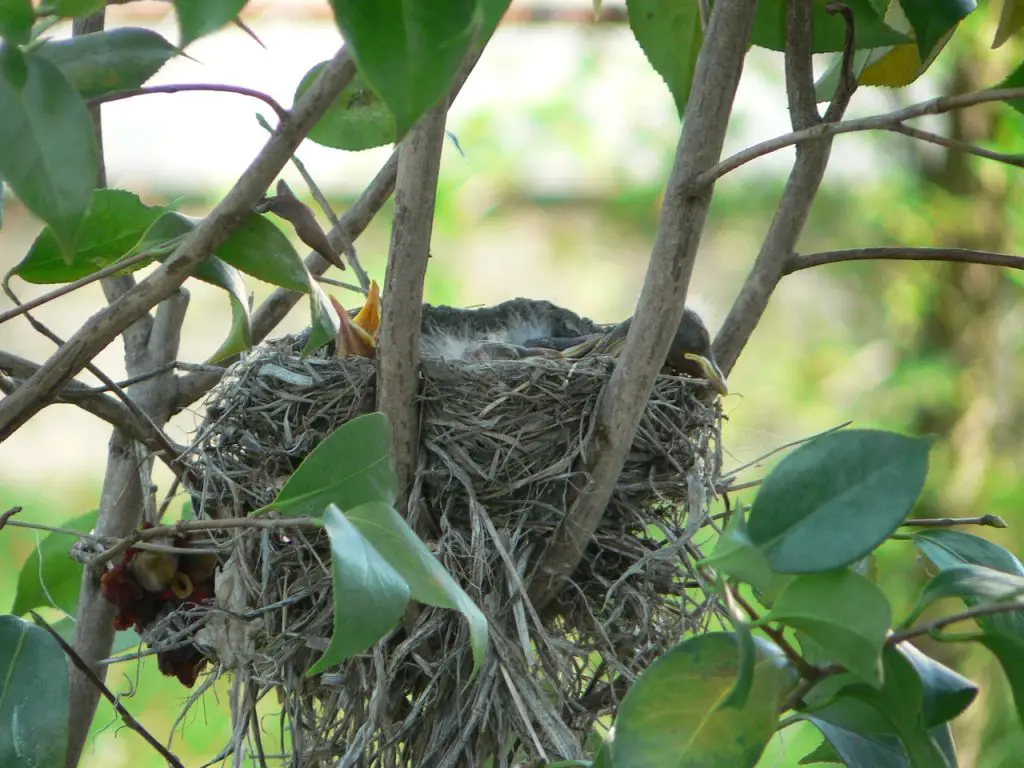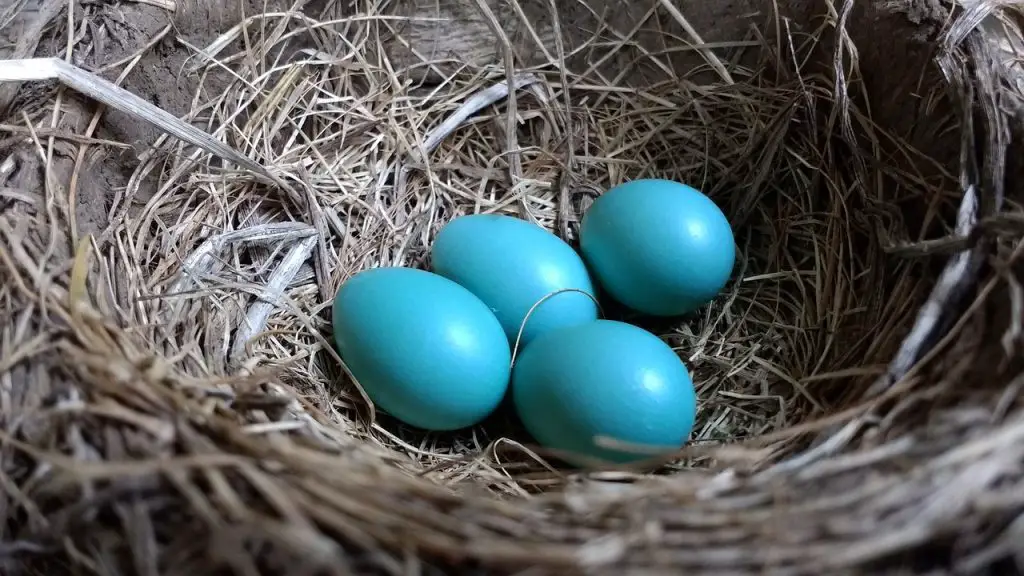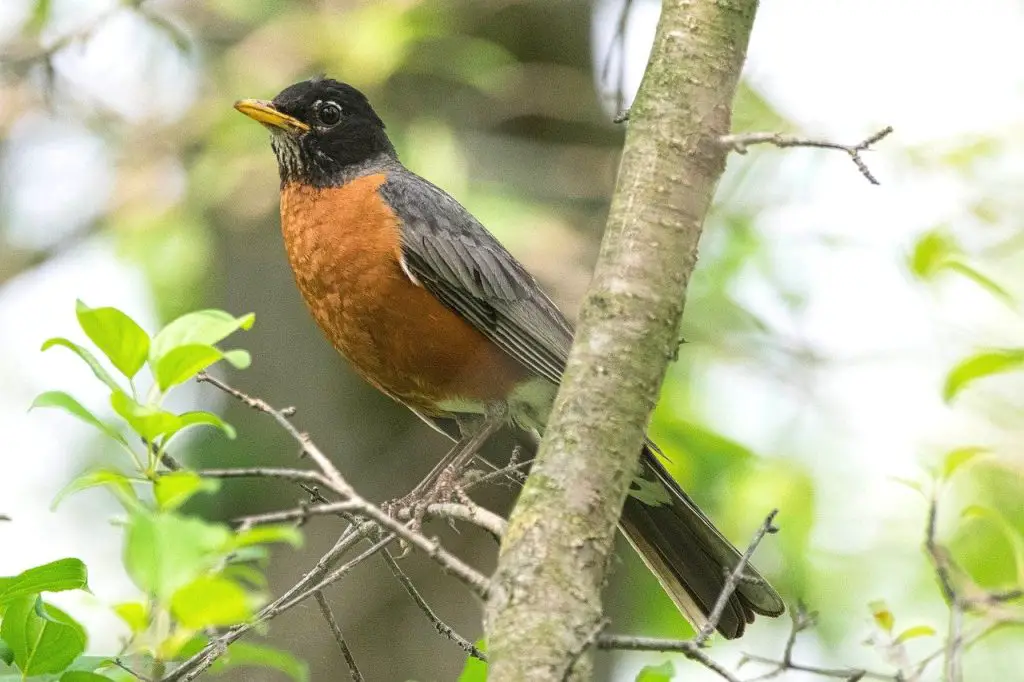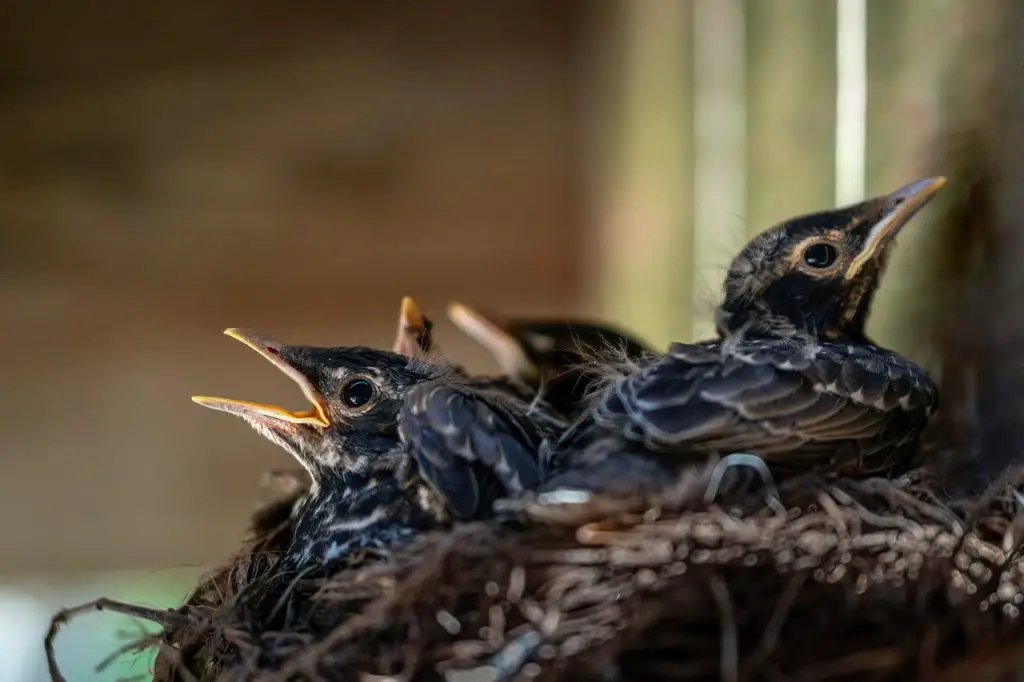Whenever I see nature in action, it’s a beautiful sight to behold. And American robins nesting are one of those beautiful sights. If you want to learn about the ins and outs of robins nesting, you are in the right place. Let’s explore everything you want to know about the nesting habits of these iconic birds.
Key facts:
- Robins typically lay a clutch of three to five eggs.
- The eggs within a robin’s nest are a beuatiful shade of blue.
What Do American Robin Nests Look Like?

American robin nests look like a rough construction of sticks and mud. It’s not necessarily a neat build.
The nest’s dimensions can vary but are generally around 6-8 inches in diameter and 3-6 inches in height. They are typically built in sheltered locations, such as tree branches, ledges, eaves, or even on man-made structures like window sills and porch lights.
Where Do American Robins Nest?
American robins are resourceful nesters, and their choice of nesting locations reflects their adaptability to various environments. They commonly nest in trees, using the sturdy branches and foliage to create safe and concealed sites. Some preferred tree types include maples, oaks, pines, and spruces.
In addition to natural habitats, American robins have adapted to urban environments, making use of man-made structures for nesting. They may construct their nests on building ledges, window sills, porch lights, and even in hanging baskets or planters.
When looking for nesting spots, female robins typically seek sheltered locations that provide protection from predators and harsh weather conditions. Their nests are carefully hidden, often obscured by leaves or other vegetation, making them challenging to spot even for keen observers.
How Do American Robins Build Their Nest?
These nests are meticulously constructed by adult robins using a combination of natural and human-made materials. These nests are typically cup-shaped and made primarily of grasses, twigs, leaves, and mud. The female robin plays a significant role in building the nest, while the male assists by gathering materials for her.
It usually takes between five to seven days to build the nest.
What Do American Robin Eggs Look Like?

American robin eggs are a sight to behold, showcasing a stunning blue-green hue that captivates observers. The eggs are typically around 1 inch in length and feature a smooth and glossy surface. The blue-green coloration is characteristic of many songbirds’ eggs and serves as a protective adaptation, blending with the surrounding nest materials and making them less conspicuous to potential predators.
What Time Of Year Do American Robins Nest?
American Robins are known for their distinct breeding season, which generally occurs during the spring and summer months. In many regions of North America, they start nesting as early as March or April. The exact timing can vary depending on the geographic location and local climate conditions.
As migratory birds, American Robins often return to their breeding grounds in the spring after spending the winter in warmer regions. Their arrival is considered a traditional sign of the changing seasons, as they herald the arrival of spring with their melodious songs and vibrant presence.
During their nesting period, female robins seek out suitable nesting sites, carefully selecting sheltered locations that provide safety for their eggs and hatchlings. The nesting season can extend into the summer months, with some robins raising multiple broods during the breeding season.
Do Robins Reuse Nests?

After successfully raising a brood, they may return to the same nesting site in subsequent years if it remains suitable and undisturbed. The female robin, in particular, plays a role in inspecting and refurbishing the old nest before laying a new clutch of eggs.
However, it’s essential to note that while robins do reuse nests, they may not do so for every breeding attempt. Factors such as nest condition, location, and environmental changes can influence their decision to reuse or build a new nest from scratch.
American Robins Nesting: Timeline
Here’s a breakdown of the robin nesting timeline.
Incubation
Female robins typically lay a clutch of three to five eggs during each breeding season. The size and number of eggs can be influenced by factors such as the female’s age, health, and environmental conditions.
Once laid, the female incubates the eggs, keeping them warm with her body heat to facilitate the development of the embryos. The incubation period typically lasts about 12-14 days until the eggs hatch, revealing the adorable hatchlings ready to embark on their journey in the world.
Chick Rearing
Once the eggs hatch, the chicks typically spend about 12 to 14 days in the nest before they are ready to fledge, or leave the nest. During this period, both the male and female robins are actively involved in feeding and caring for the chicks.
After fledging, the young robins continue to receive parental care and feeding for another 10 to 20 days as they gradually gain strength and develop their flight capabilities. The parents guide them to food sources and provide protection from potential threats during this critical post-fledging period.
In total, from the time the eggs are laid until the young robins become fully independent, the process usually takes about 3 to 4 weeks. However, it’s important to remember that individual variations and environmental conditions can influence the timeline of rearing chicks.
How Many Broods In A Year?
American robins typically lay two to three broods in a breeding season. As skilled and adaptable breeders, they take advantage of the favorable conditions of spring and summer to raise multiple sets of chicks. The exact number of broods can vary depending on factors such as geographic location, climate, and availability of food resources.
Will An American Robin Abandon Their Nest?
Yes, it is possible for an American Robin to abandon its nest under certain circumstances. If the nest becomes disturbed or destroyed, either by human interference, natural disasters, or predation, the robin may choose to abandon the site. Similarly, if the eggs or young chicks are threatened or harmed, the adult robins might desert the nest to ensure their own safety.
Additionally, if the nest site proves unsuitable or becomes infested with parasites or other hazards, the adult robins may abandon it in search of a more secure location for their breeding attempts. The well-being of the robin parents and their survival instincts play a significant role in determining whether they continue to use a particular nest or decide to find an alternative nesting site.
However, robins typically show strong fidelity to their nests, and they often attempt to repair and reuse the same nest for subsequent broods, as long as it remains suitable and undisturbed.
What Do Baby Robins Look Like?
Baby robins, also known as fledglings, look very different from their adult counterparts. When they first hatch, they are typically naked or have sparse white down feathers, giving them a vulnerable and delicate appearance. As they grow, their bodies become covered in a mix of grayish-brown feathers, which gradually develop into the more familiar rusty-red breast of adult robins.
One of the most noticeable features of baby robins is their large, bright yellow gape, or the inside of their mouths. This gape serves as a visual signal to their parents, indicating their readiness to be fed. As they grow, the gape fades, and their bills transition from a yellowish hue to the characteristic dark coloration of adult robins.
Baby robins have shorter tails and stubbier wings compared to adults, which make them appear somewhat disproportionate. However, as they continue to mature and strengthen their flight muscles, their bodies become more balanced, and they gain the ability to fly confidently alongside their parents

American Robins Nesting: Frequently Asked Questions
You have questions about American robins nesting. I have answers.
Do American Robins Use Nest Boxes?
Yes, American Robins can use nest boxes for nesting. However, the boxes must be in an appropriate location. Additionally, these birds tend to prefer open-fronted boxes with a clear view of the surroundings.
Can American Robins Nest in My Backyard?
American Robins may nest in your backyard if suitable nesting sites are available.
Do American Robins Mate For Life?
No, American Robins do not mate for life. Instead, they form new pair bonds each breeding season.
Final Take on American Robins Nesting
Observing the journey from the brilliant blue-green eggs to the fledglings taking flight is a testament to the wonders of nature and the delicate balance of life in our surroundings. If you spot a robin nesting, give it the space it needs to feel safe.